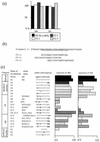Precise characterization of norovirus (Norwalk-like virus)-specific monoclonal antibodies with broad reactivity
- PMID: 12791850
- PMCID: PMC156499
- DOI: 10.1128/JCM.41.6.2367-2371.2003
Precise characterization of norovirus (Norwalk-like virus)-specific monoclonal antibodies with broad reactivity
Abstract
We have been characterizing monoclonal antibodies against Norovirus (Norwalk-like virus). In the course of our study, two monoclonal antibodies generated against Norovirus genogroup II capsid protein were found to react not only to genogroup II but also to genogroup I recombinant capsid proteins. In addition, we showed that these two monoclonal antibodies reacted to a 40-amino-acid-fragment located close to the N-terminal region of genogroup II Norovirus. Similar reactivity was observed with the equivalent region of genogroup I Norovirus. In this study, we confirmed that the epitopes of the two monoclonal antibodies existed within an 11-amino-acid peptide. To obtain an idea of the reactive ranges of the two monoclonal antibodies toward different strains of Norovirus, their reactivities were investigated using 16 types of peptide constructed according to the data in GenBank and 8 recombinant capsid proteins (7 whole capsid proteins and 1 short [80-amino-acid] protein fragment). A characteristic broad reactivity of the two monoclonal antibodies is clearly shown by the results of this study. Thus, these monoclonal antibodies could be useful tools for detecting a broad range of Norovirus strains.
Figures



References
-
- Green, S. M., P. R. Lambden, Y. Deng, J. A. Lowes, S. Lineham, J. Bushell, J. Rogers, E. O. Caul, C. R. Ashley, and I. N. Clarke. 1995. Polymerase chain reaction detection of small round-structured viruses from two related hospital outbreaks of gastroenteritis using inosine-containing primers. J. Med. Virol. 45:197-202. - PubMed
-
- Jiang, X., J. Wang, and M. K. Estes. 1995. Characterization of SRSVs using RT-PCR and a new antigen ELISA. Arch. Virol. 140:363-374. - PubMed
-
- Jiang, X., D. O. Matson, W. D. Cubitt, and M. K. Estes. 1996. Genetic and antigenic diversity of human caliciviruses (HuCVs) using RT-PCR and new EIAs. Arch. Virol. Suppl. 12:251-262. - PubMed
-
- Kawamoto, H., K. Yamazaki, E. Utagawa, and T. Ohyama. 2001. Nucleotide sequence analysis and development of consensus primers of RT-PCR for detection of Norwalk-like viruses prevailing in Japan. J. Med. Virol. 64:569-576. - PubMed
MeSH terms
Substances
Associated data
- Actions
- Actions
- Actions
- Actions
LinkOut - more resources
Full Text Sources
Other Literature Sources
Medical

